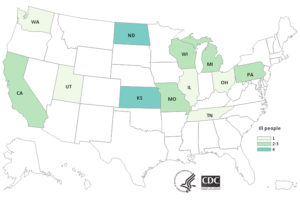Mystery E. coli Outbreak 1 – possibly linked to 2018 Yuma Romaine E. coli Outbreak.
As of October 28, 2020, a total of 21 people infected with the outbreak strain of E. coli O157:H7 have been reported from eight states.

Illnesses started on dates ranging from June 6, 2020, to October 5, 2020. Ill people range in age from 2 to 75 years, with a median age of 24 years. Sixty-seven percent of ill people are female. Of 16 ill people with information available, 8 hospitalizations have been reported, including 1 person who developed hemolytic uremic syndrome (HUS), a type of kidney failure. One death has been reported from Michigan.
Several ill people have been identified as part of an illness cluster at a restaurant. An illness cluster is defined as two or more people from different households who report eating at the same restaurant location, attending a common event, or purchasing food at the same grocery store in the week before becoming ill. Investigating illness clusters can provide critical clues about the source of an outbreak. If several unrelated ill people ate or shopped at the same location of a restaurant or store within several days of each other, it suggests that the contaminated food item was served or sold there.
The strain of E. coli O157:H7 causing illness in this outbreak has previously caused outbreaks linked to different sources, including an outbreak linked to romaine lettuce in 2018. However, food linked to a previous outbreak alone is not enough to prove a link in another outbreak of the same strain. This is because different foods can be contaminated by the same strain of bacteria.
Mystery E. coli Outbreak 2 – possibly linked to 2019 Salinas Romaine E. coli Outbreak.
As of October 28, 2020, a total of 23 people infected with the outbreak strain of E. coli O157:H7 have been reported from 12 states.

Illnesses started on dates ranging from August 17, 2020, to October 8, 2020. Ill people range in age from 5 to 81 years, with a median age of 21 years. Sixty-seven percent of ill people are female. Of 15 ill people with information available, 10 hospitalizations have been reported, including 2 people who developed hemolytic uremic syndrome (HUS), a type of kidney failure. No deaths have been reported.
State and local public health officials are interviewing ill people to determine what they ate and other exposures in the week before they got sick. People have reported eating a variety of foods, including leafy greens. Of the 13 people interviewed to date, all reported eating various types of leafy greens, like iceberg lettuce (9), romaine lettuce (8), mixed bag lettuce (6), and spinach (9).
This outbreak is caused by the same strain of E. coli O157:H7 that caused an outbreak linked to romaine lettuce in 2019. However, food linked to a previous outbreak alone is not enough to prove a link in another outbreak of the same strain. This is because different foods can be contaminated by the same strain of bacteria.
E. coli: Marler Clark, The Food Safety Law Firm, is the nation’s leading law firm representing victims of E. coli outbreaks and hemolytic uremic syndrome (HUS). The E. coli lawyers of Marler Clark have represented thousands of victims of E. coli and other foodborne illness infections and have recovered over $700 million for clients. Marler Clark is the only law firm in the nation with a practice focused exclusively on foodborne illness litigation. Our E. coli lawyers have litigated E. coli and HUS cases stemming from outbreaks traced to ground beef, raw milk, lettuce, spinach, sprouts, and other food products. The law firm has brought E. coli lawsuits against such companies as Jack in the Box, Dole, ConAgra, Cargill, and Jimmy John’s. We have proudly represented such victims as Brianne Kiner, Stephanie Smith and Linda Rivera.
If you or a family member became ill with an E. coli infection or HUS after consuming food and you’re interested in pursuing a legal claim, contact the Marler Clark E. coli attorneys for a free case evaluation.
Additional Resources